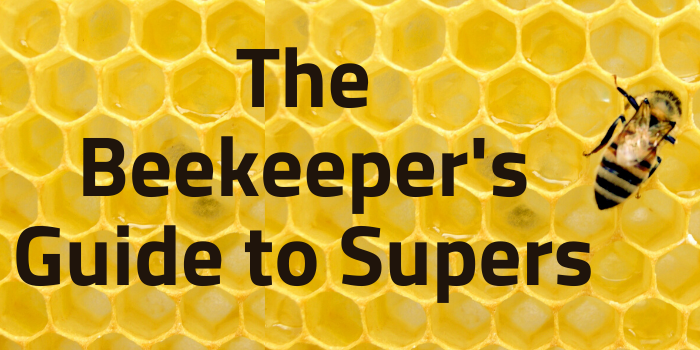
The Beekeeper's Guide to Supers
What are supers?
Bees use supers to store honey, pollen and brood. Supers come in varying heights and sizes. A deep-sized super is 9-5/8” in height and can weigh 90 pounds when full. A medium-sized super is three-fourths the capacity of the deep-sized super and is sometimes referred to as the Illinois super. It is 6-5/8” in height and can weigh close to 60 pounds when full.
A shallow-sized super is half the capacity of a deep-sized one at 5-5/8” in height and weighs approximately 40 pounds when full. Additionally, depending on their size, supers are designed to hold eight or ten frames. Supers can be used as brood chambers which are also designed to hold eight or ten frames.
Since the larger and deeper super is so heavy when full, many people opt to use a medium-sized super instead. Those who still struggle with the weight of the medium super may choose to use a shallow one. Many companies only sell the medium-sized supers because that size is most commonly used by the average apiarist.
How many frames should I choose?
Some beekeepers choose to only use eight or nine frames in their ten frame supers or seven in their eight-frame supers. With greater spacing between the frames, the bees can draw out a wider comb on each frame. Interestingly enough, bees can pack more honey in nine frames in a ten-frame super than they can in the full ten frames due to the wider comb.
Is wider better?
Wider combs on the frames can be of great benefit when it comes time to harvesting the honey. Wider combs generally extend beyond the edges of the wooden frame making it easier to uncap the frames for honey extraction. The uncapping knife rides on the edge of the frame, uncapping all the cells with ease. A seven frame spacer tool for use with the eight frame super or a nine frame spacer tool for use with the ten frame super takes the guesswork out of spacing. These tools provide the bees with the perfect spacing between the frames to build out a consistent width comb.
When should I add a super?
You can add as many supers on your hives as the bees can fill. It’s important that honey supers are added when the nectar flow is heavy to give the bees room to store honey and to prevent overcrowding inside the hive. How do you know when a new super is needed? A good rule to follow is to add another super when eight of ten frames in the top hive body are being used by the bees.
It’s best to add a super too early rather than too late, so if in doubt, err on the side of too early. If a super is not added in a timely fashion, you run the risk of the bees swarming. If added too early, however, they will have a lot of empty real estate to protect from wax moths and other nest invaders. Plus, if the workers move to the new super before the brood chamber has been adequately filled, they may not have enough honey stores to make it through the next winter.
How about splitting the hive?
If you do any late-season splits, be sure to supplemental feed the colony until it is established. Newly established colonies will also require supplemental feeding. There are many types of supplemental feeders available. Top feeders are added to the hive just like a super. Perforated lids screw onto mason jars to create jar feeders that attach to the front of the hive entrance. In a medium-sized super, a frame can be replaced with a one-gallon or two-gallon frame feeder.
Most apiarists add a queen excluder between the brood chamber and the honey supers to keep the queen from laying her eggs in the supers. Worker bees can pass through the excluder; however, the queen’s larger body prevents her from going into the honey supers.
General Question About Bee Hive Supers
What Are the Benefits or Drawbacks of Using a Queen Excluder?
A queen excluder keeps the queen in the brood chamber, preventing her from laying eggs in the honey supers, ensuring higher quality honey. However, it can restrict worker bee movement if clogged, and during nectar flow, the queen may run out of space to lay eggs, causing stress or swarming.
How Does a Beekeeper Decide When to Harvest Honey and What Are Best Practices?
Harvest honey when bees cap the cells, indicating it's dehydrated. Minimize bee disturbance by using a bee brush or a bee escape board. Ensure the process is stress-free for the bees.
Can the Material of the Super Affect Hive Health or Honey Quality?
Yes, wooden supers offer good insulation but need maintenance, while plastic supers are durable and easy to clean but may affect temperature regulation. Cleanliness and maintenance of supers are crucial for hive health and honey quality.
What Are the Challenges in Managing Full Supers' Weight for Beekeepers with Physical Limitations?
Full supers are heavy. Use smaller supers, hive tools, and mechanical aids like lifts or trolleys to reduce physical strain. Design the apiary to minimize heavy lifting.
How Does a Beekeeper Ensure Hive Health When Adding or Replacing Supers?
Ensure the colony is strong enough to protect new spaces. Avoid leaving empty supers on the hive, clean and freeze frames to kill pests, and use integrated pest management strategies to safeguard hive health.
For more beekeeping information and advice, check back here and follow us on YouTube and Facebook.



Leave a comment